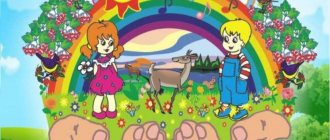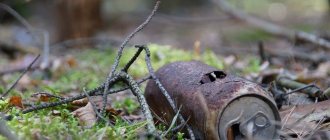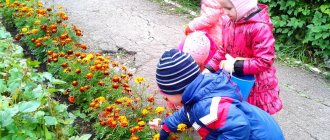Goals and objectives of environmental education for preschool children
— From simple to more complex
— From the particular to the more general
The process of forming the foundations of environmental knowledge in children can be conditionally divided into several stages, following each other or in parallel and allowing to create the most complete picture of the world. In this case, it is necessary to take into account the age characteristics and general level of development of the children in the group.
Approximate sequence for presenting environmental knowledge:
— Nature and objects made by human hands.
- Living nature: humans, all animals, all plants. Signs of a living organism: eats, breathes, moves, grows, reproduces.
— Inanimate nature is a habitat for all living things: terrestrial, underwater, air.
— Interrelation and interdependence of living beings with the environment: features of the external structure that contribute to adaptation to environmental conditions, adaptation to environmental changes by season; molting, food reserves for the winter, hibernation, leaf fall of plants, etc., ecosystems (biocenoses) and their types: ecosystems of forests, meadows, lakes, seas and others.
By daily revealing to a child the beauty, uniqueness and essence of certain natural objects and phenomena, one can form a stable interest in the surrounding nature and develop artistic and creative abilities. Observing in nature, children reflect everything they saw and felt in their drawings, crafts made from paper, plasticine, natural materials, as well as in play activities.
In the process of environmental education, children's speech develops. This is very important for every child and is especially important for children in speech therapy groups with general speech underdevelopment (GSD). This starts from the selection of adjectives when describing natural objects and ends with children inventing stories, fairy tales, and riddles on environmental topics.
When forming concepts and ideas about natural objects, about various natural phenomena, it is necessary to constantly show that in nature everything is connected, everything depends on each other. If, under the influence of some factors, changes occur in one link, then changes occur in many other links along the chain, leading to undesirable and often harmful consequences, both for nature and for man himself. By introducing children to the negative impacts of humans on nature, revealing the integrity of nature, it is necessary to instill in them a sustainable need for a caring and careful attitude towards the entire world around them, a desire to preserve and increase its wealth. If such needs are firmly established in children, then this will be the beginning of the formation of the foundations of an ecological culture in them, which is part of the general culture of a person’s personality.
MAGAZINE Preschooler.RF
Main directions of environmental education of preschool children.At the main stage of social development, the issue of environmental education becomes particularly acute. In this regard, it is necessary to pay more attention to the environmental education of children from the first years of life, since it is during this period that the child develops his first worldview - he receives emotional impressions about nature and society, accumulates ideas about different forms of life, the basis of environmental thinking is formed, consciousness and culture.
During this period, the foundations for interaction with nature are laid; with the help of adults, the child begins to recognize it as a common value for all people. Wildlife has long been recognized in pedagogy as one of the most important factors in the education and upbringing of preschool children.
Communicating with it, studying its objects and phenomena, preschool children gradually comprehend the world in which they live: they discover the amazing diversity of flora and fauna, realize the role of nature in human life, the value of its knowledge, experience moral and aesthetic feelings and experiences that motivate them take care of the preservation and enhancement of natural resources.
The severity of modern environmental problems has confronted pedagogical theory and practice with the task of educating the younger generation in the spirit of a careful, responsible attitude towards nature, capable of solving issues of rational environmental management, protection and renewal of natural resources. In order for these requirements to become the norm of behavior for every person, it is necessary to purposefully cultivate a sense of responsibility for the state of the environment from childhood.
The goal of our work is to form ideas in preschool children about the flora and fauna of the natural world of their native land in connection with their habitat, environmental behavior in nature and respect for it.
To achieve this goal, the main tasks were identified:
- deepen and expand environmental knowledge
- instill basic environmental skills and abilities - behavioral, cognitive
- develop cognitive, creative, social activity of preschool children during environmental activities
- to form (nurture) feelings of respect for nature.
All work on environmental education was carried out in two directions: in direct educational activities and in everyday life. The knowledge, skills and abilities acquired by the children were consolidated every day in kindergarten and at home.
From the age of 3-4, children’s attention was drawn to some of the most striking noticeable phenomena and events characteristic of different times of the year. We gave the children information little by little, using games and fun. To consolidate, the same objects and phenomena were repeated several times.
In the second younger group, the children were involved in active participation in caring for indoor plants: watering, wiping the leaves. Each child gradually became familiar with material on caring for plants so as not to harm them. With the onset of winter, we fed the birds on the site. We made feeders together with our parents and placed them close to the window so that the children could watch the birds every day.
In older preschool age, they were involved in subject-transforming activities in nature. They were taught to intelligently use nature, work, conserve natural resources, and acquire practical experience in relation to the natural environment. As a result, the children developed practical knowledge, personal experience of influencing the environment and saving wealth, enriching cognitive interests, and the need for activity in the natural environment.
Based on the leading didactic principles and analysis of the interests and inclinations of preschoolers, various forms of environmental education were used
- mass;
- group;
- individual.
Mass forms included environmental festivals, role-playing games, and work on the site.
Group forms included excursions, hiking trips to study nature, and environmental workshops.
Individual forms of observing animals and plants, making crafts, drawing, modeling.
For each observation, a small amount of information was selected. Ideas about objects and natural phenomena were formed in preschoolers gradually, in the process of repeated “meetings” with them. In each subsequent observation, they recalled, clarified, consolidated and specified, and expanded the received ideas. In organizing observations, they thought through the system and their interrelationship, which ensured that children understood the processes and phenomena that they observed. Observation stimulated the children's interest and their cognitive activity.
Along with observations, visual illustrative material was widely used, which helped to consolidate and clarify children’s ideas obtained during direct observations. With their help, preschoolers formed ideas about objects and natural phenomena that are currently impossible to observe, children became familiar with ongoing phenomena in nature (seasonal changes), and information of natural history content and nature was generalized and systematized.
Play played a major role in introducing preschoolers to nature. Plot-role-playing games assumed the presence of natural history, environmental and environmental content and the existence of certain knowledge: “Trip to an exhibition” , “Expedition to Africa” , “Journey to the sea” .
We selected a variety of didactic games with environmental content: “Wild - domestic” , “Poisonous and safe plant” , “Where, whose house?” , “What is harmful and beneficial for nature (water)?” , “Dangerous - not dangerous” , “Choose edible mushrooms, berries” , “Let's pack a backpack for the road” , etc.
Used object games using natural materials (pine cones, pebbles, shells, etc.) contributed to the development of the child’s thinking. For example, objects can be classified according to different characteristics (color, size, shape). It is important that children also participate in collecting natural materials.
They played intellectual games - “KVN” , “What? Where? When?" , “Brain - Ring” , the children were delighted not only with the game, but also with the preparation for the game itself.
Particular attention requires the creation of conditions for independent environmental play, research activities and modeling. In a corner of nature, we created a collection of natural waste materials for making crafts.
The most important form of working with children is work in nature. This type of activity, like no other, contributed to the formation in preschoolers of an awareness of the correct attitude towards nature. In the process of working, the children had the opportunity to put their knowledge into practice, acquire new ones, and clearly see the existence of various relationships in nature (plants, animals and the environment). They developed the necessary care skills and a sense of responsibility for a living organism.
Positive emotions were evoked in children during drawing classes, applique work, modeling and design, performing performances on natural history themes, reading fiction - all this contributed to the formation of a consciously correct attitude towards nature in preschoolers and attracted them to environmental activities.
Environmental education of preschool children can be considered as a process aimed at developing an environmental culture for all family members. Environmental education (enlightenment) of parents is one of the extremely important and at the same time one of the most difficult areas of work of a preschool institution. One of the primary tasks is to involve adult family members (even grandparents to a greater extent than busy dads and moms) in working together. The preschool age of a child is a period when many of them themselves strive for contact and cooperation with teachers, which is very important for environmental education. The family as an environment for personality formation has a huge influence on the formation of the child’s foundations of an ecological worldview. The foundation of moral education is also laid in the family and specifically during early childhood.
Adults received environmental information:
- at parent meetings
- during a visit to the kindergarten territory
- from consultations for parents
- in joint activities with children.
In addition to traditional forms of work and preschool education and family, we actively use innovative forms and methods of work:
- Round table “Ways to implement the system of environmental education in kindergarten” ;
- Thematic exhibitions: photo exhibition “Pets” , exhibition of drawings “Don’t be late, save the planet!” ;
- Family meetings with an environmental focus: “Together along our ecological path” , “Plant a tree” ;
- Family talent competition: “Miracle - Vegetables” , “Save the Christmas Tree” , “Bird’s Canteen” .
Working with parents should be a gradual and ongoing process, and the environmental information we offer to parents is personally meaningful to them. The joint activity of an adult and a child contributed to cooperation, emotional and psychological rapprochement between the child and the adult.
Thus, based on all of the above, we can conclude that when organizing work with preschool children, it is necessary to focus on the age-related, individual and differentiated characteristics of children. It is also necessary to properly organize interaction with the family so that the work on environmental education continues at home.
Literature
- Kulikovskaya, I. E. Children's experimentation [Text] / I. E. Kulikovskaya, N. N. Sovgir. – M.: Publishing House of the Pedagogical Society of Russia, 2011. _ P.79.
- Makhaneva, M. D. Ecology in kindergarten and primary school. Methodological manual [Text] / M. D. Makhaneva. - M.: TC Sfera, 2010. - P. 171.
- Nikolaeva, S. N. Methods of environmental education of preschool children [Text] / S. N. Nikolaeva. – M., 2009. – P. 57.
| Next > |
Creating a favorable ecological environment
The process will be successful when a favorable, positive ecological environment is created around the child.
The presence of experimental plots in the garden, an ecological trail, a winter garden, an aquarium, and a living corner makes it possible to increase the efficiency of all forms and methods of work in this area.
There should be no unfoundedness. Children need to see everything in person, touch it, smell it, stroke it. Then the common efforts of educators and parents will bring results.
Ecological development of preschool children
Not what you think, nature: Not a cast, not a soulless face - She has a soul, she has freedom, She has love, she has language...
F. I. Tyutchev.
Love for nature, a conscious, careful and interested attitude towards its beauty, its wisdom, its laws, its problems should be cultivated in every person from an early age in the family and in preschool institutions. In our country, environmental education and upbringing is carried out in a system of state and public forms that form the environmental consciousness of the Russian citizen.
A variety of natural objects allow the teacher to organize useful and interesting activities for the students. Children develop curiosity in the process of observing, comparing, playing and working in nature, and they also become familiar with the properties and qualities of objects. Children learn to notice natural phenomena, their changes and development, and preschoolers are encouraged to use the acquired knowledge and skills in practice. The guys pour water on the snow to create buildings, moisten the sand, and coat the bottom of the canals with clay to retain water. Further improvement of knowledge and development of mental abilities occurs in the process of work in nature.
Nature itself influences the development of a child’s personality and this is associated with the formation of certain knowledge about it. Knowledge about nature helps the child to distinguish the signs, properties and qualities of objects. Speaking about the tasks facing a teacher who introduces children to nature, three tasks can be distinguished.
- Formation of an elementary knowledge system in children. Children's knowledge about the nature of preschool age is usually formed by ideas and their expressed signs
- Formation of labor skills and abilities in children. As children grow up, their labor skills are not destroyed, but rather improved. Caring for plants and animals brings joy to the child and makes other children want to help him.
- Formation of love for nature. Nature is primarily the basis of beauty, the source of music, poetry and painting. A child who has once experienced the beauty of nature will always protect, preserve and love it as a source of joy.
The main goal of environmental development and education is the formation of an environmental culture in preschool children.
And this is only possible if the teacher and parents have an environmental consciousness, and if they work together with children.
Through environmental knowledge, the child learns about his own characteristics and begins to feel his species identity. By learning about nature and all living things on earth, children experience a spiritualization of existence and an aesthetic perception of nature. The knowledge and skills acquired in the preschool period help the individual to further establish himself in the world and strengthen self-confidence. Environmental activity allows preschoolers to master the ability to behave in nature, and also significantly increases the level of environmental awareness.
Literature:
Egorenko L.I. Environmental education of preschoolers and primary schoolchildren. M.: ARKTI, 1999.
Kondratyeva N.N. “We” Children's environmental education program. - St. Petersburg: Detsvo-press, 2000.
F. Tyutchev, L.A. Kameneva Methods of introducing children to nature in kindergarten. -M.: education, 1992.
Criteria for environmental education of older preschoolers
The famous teacher and scientist T. A. Markova believes that the main criteria can be:
- children's goodwill towards all living things;
- degree of interest in living and inanimate nature;
- desire to contact natural entities;
- ability to care for plants and animals.
Ecological culture allows you to live in harmony with the surrounding nature, feel responsible for your steps and understand the consequences of a harmful attitude towards the earth.
Effective environmental education through play activities
Through the game, the understanding of the life of plants and animals gained during excursions and direct contact with the inhabitants of the meadow, forest, and pond is consolidated.
Ecological game technology:
- Selecting a topic from the program.
- Determining the purpose and conditions of the game.
- Thinking through the stages of the game.
- Distribution of roles.
- Getting to know the rules.
The method of teaching such games depends on the characteristics of the preschooler’s age. There are different types of games: subject, board, verbal, creative. When creating creative game situations, you can use fairy-tale characters.
For example, Little Red Riding Hood goes to her grandmother through the forest and can meet its different inhabitants and collect leaves of forest trees. Toys are important for games: dolls, fish, animals. They should be aesthetic, bright, realistic. In this case, the game stimulates the activity of children and increases their emotional mood.
Problems of environmental education
The main problem in this direction is the low equipment of gardens. Conditions are necessary to create a winter garden and mini-laboratories. To carry out gaming activities, you need didactic materials, maps, manuals, models, toys.
The second problem is the viability of the developed education system. The environmental education program and the entire methodology for environmental education of preschoolers will be implemented in the case when each stage of work and the result of the work are thought out: what we want the student to be like when he enters school.
Environmental education in kindergarten
Already at a young age, the baby begins to interact with peers, with adults, with objects of nature.
The child shows curiosity, asks why questions, and adopts the values and traditions of elders. Ages from 3 to 6 years are the most susceptible. A preschooler learns the experience of adults based on trust in them. From an early age he learns to actively cooperate with nature and empathize with it.
Environmental education starts in the family and continues in the nursery. Each preschool institution draws up its own program for the formation of environmental knowledge, covering the entire educational process, starting with a walk and ending with educational activities.
Where does the formation of environmental awareness among preschoolers begin in preschool educational institutions?
The first step is to create conditions for this work: a corner of nature with an aquarium, small animals in a group, a small winter garden, a nature museum. A living area can contain birds, fish, reptiles, and small animals.
The guys feed them, clean them, observe them, and study their characteristics. Walks are also important, when children observe and draw conclusions about certain phenomena in living and inanimate nature.
The role of parents in environmental education cannot be belittled. Now families have cats, dogs, parrots, and turtles. There are aquariums and indoor plants. Adults should daily introduce children to the world of nature, to comprehend its secrets, so that from early childhood a feeling of unity with the world around them arises.





